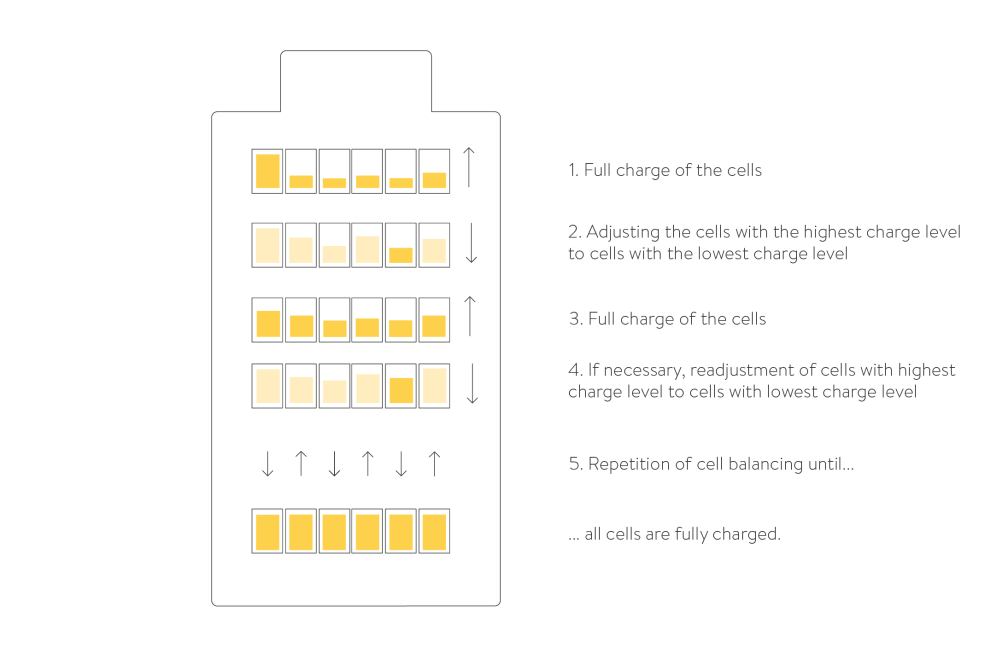Battery maintenance: How does your battery management system (BMS) help?

What Is the benefit of battery maintenance in solar storage systems? And why Is it necessary for the sonnenBatterie?
This article aims to explain the specific benefits of battery maintenance in energy storage systems and its influence on the battery charging cycles, with a focus on our product, the sonnenBatterie. The sonnenBatterie is a durable, high-quality product that reliably provides our customers with clean energy. It consists of several individual battery cells. To ensure that the individual battery cells in our storage system function optimally and achieve a long lifespan, many complex processes take place within the sonnenBatterie. All of these processes run so smoothly that our customers usually don’t even notice them. This battery maintenance is crucial for ensuring a long lifespan of the storage system and is automatically controlled by our advanced Battery Management System (BMS). During the summer months, battery maintenance is supported by the regular use of solar power. In the winter months, when less solar energy is available due to the lower output of photovoltaic (PV) systems, the BMS takes over this important process. This principle also applies to other energy storage systems, but sonnen places special emphasis on battery care and preservation through smart and cutting-edge technology.
What is a battery management system (BMS)?
The Battery Management System (BMS) is a key element of the sonnenBatterie that monitors the state of charge and controls the battery’s maintenance. A crucial part of the system which ensures that the storage system operates reliably for a long time. The BMS regularly performs maintenance processes such as full charging and trickle charging to protect the battery. These measures help to maximize the lifespan of the energy storage system, allowing it to be used for over 10,000 charging cycles. The sections below provide more information on the storage system's lifespan, which, in the case of the sonnenBatterie, surpasses 10,000 charging cycles.
What is the purpose of a full charge in a battery?
Battery maintenance includes full charging and trickle charging, which we will explain in detail. A full charge is necessary to:
- calibrate the calculation of the state of charge (SoC),
- prevent the wear of individual battery modules, and
- balance the cells so that voltage and charge differences between the cells are equalized.
This process is particularly important for batteries to keep the charging cycles of the solar battery even and efficient, especially in winter, when less solar energy is available.
How does full charging improve battery maintenance?
A full charge is necessary to optimize battery maintenance. It ensures that all battery cells are charged evenly, balancing voltage and charge differences. This allows the Battery Management System to accurately determine the actual state of charge, which is important to maximize the battery’s lifespan.
When does trickle charging happen?
A trickle charge is performed when little solar power is generated by the PV system over an extended period (e.g., in the winter months), and the battery modules of the sonnenBatterie are fully discharged. This prevents a deep discharge, which could lead to permanent damage to the battery cells. During trickle charging, some power is drawn from the grid to prevent the state of charge from dropping further after reaching 0%. Once enough solar energy is available again, the sonnenBatterie resumes charging normally with solar power.
Balancing and Serial Balancing: Cell Maintenance vs. Module Maintenance
Balancing (also called cell maintenance) and serial balancing (also called module maintenance) are two key methods for preserving battery lifespan. To clarify: A battery module in the sonnenBatterie consists of several individual battery cells. Module maintenance, or serial balancing, serves to equalize the state of charge of different battery modules. In cell maintenance, or balancing, the state of charge of a battery module is equalized at the cell level, so that each individual battery cell has the same state of charge. Over time, there are natural variations in voltage and charge between the cells, which are corrected through these maintenance processes.
The image shows the process of cell balancing, where the cells are equalized through repeated charging and discharging so that all cells reach the same state of charge.

"Surplus Fullcharge": maximizing the use of solar power
Another unique feature of the sonnenBatterie is "Surplus Fullcharge". With this smart function, you have more control over your battery. When the function is activated, the battery is charged only by the surplus from your PV system to reach 100% state of charge (SoC). When the sun is strong, such as in the summer, the full charge is completed relatively quickly. In periods with less sunlight, such as in the winter, it may take several days for the battery to fully charge.
What is deep discharge in an energy storage system?
Deep discharge in an energy storage system occurs when the battery is discharged to a critical level, often below 0%. If an energy storage system experiences deep discharge, this can cause permanent damage to the battery cells, reducing their storage capacity. A good Battery Management System ensures that a deep discharge of the battery is prevented through regular maintenance processes like trickle charging.
How does the battery management system prevent deep discharge in an energy storage system?
The Battery Management System continuously monitors the state of charge. Once the state of charge reaches a critical point, it automatically activates the trickle charging to prevent a deep discharge. This protects the battery cells from permanent damage and ensures a longer lifespan for the storage system.
Lifespan of the sonnenBatterie: why lithium iron phosphate is crucial
The sonnenBatterie uses lithium iron phosphate as battery technology, which withstands more than 10,000 charging cycles while still maintaining 80% of its capacity. After 15,000 charging cycles, the capacity is typically around 60%. This outstanding lifespan is one of the reasons why the durability of a PV storage system with sonnen is so high.
The exceptionally high number of charging cycles in the energy storage system is one of the key features of the sonnenBatterie, contributing to its long lifespan.
How long does battery maintenance take?
Generally, battery maintenance takes about 24 hours. In some cases, the process may extend over the following days. During this time, the charge level displayed in the sonnenApp or in the customer portal may not change or may increase suddenly. However, if the "Surplus Fullcharge" function is activated, battery maintenance, especially in winter, may take longer because the battery is charged only by the PV surplus. In regions with little sunlight, it can take several days for the battery to fully charge.
What does battery maintenance cost?
All maintenance measures – from full charging to trickle charging and cell balancing – are included in the sonnenBatterie’s service package. So you don’t need to worry about additional costs, as these maintenance measures are automatically carried out by the software to care for your battery.
Conclusion: battery maintenance as the key to a long lifespan
All maintenance measures – from full charging to trickle charging and cell balancing – are designed to maximize the lifespan of an energy storage system. Regular battery maintenance through the Battery Management System guarantees that the sonnenBatterie functions optimally, even when sunlight is limited. Thanks to the maintenance processes and innovative features like "Surplus Fullcharge", you have control over when and how your battery is charged, while also maximizing the use of solar energy.
Careful battery maintenance and the Battery Management System ensure that the lifespan of your energy storage system is maximized.

